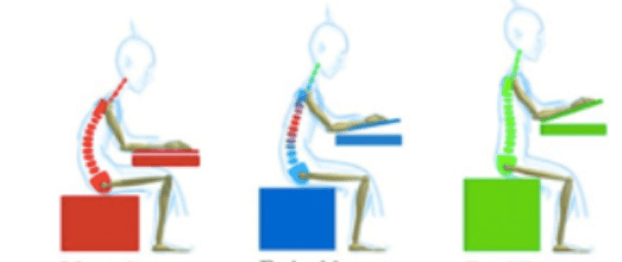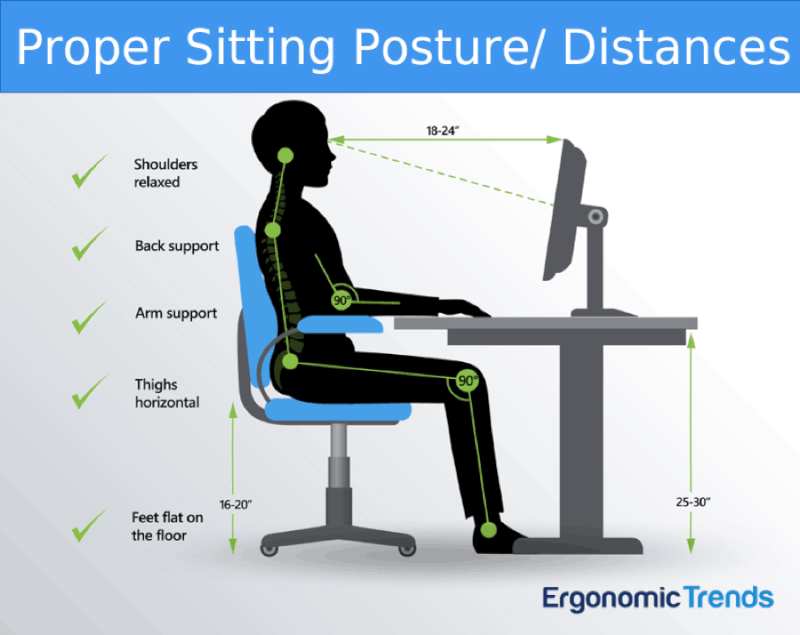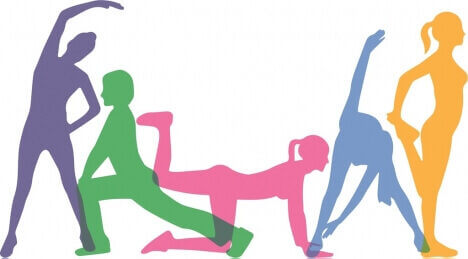During this difficult time, lots of people are working from home.
Many are struggling to try to find that comfort working from the comfort of their own home. If you are new to working from a home office you will want to review your setup.
Sitting position: be at the good height
If you can adjust your chair: minimum of 90° between your chest and your thighs with your feet flat on the floor.
If < 90°, your knees are higher than your hips level your psoas (hip flexor) will get tight and will pull lower back forward when you will stand up. You could also experience lower back pain.
Have your knees relaxed and bent at 90°
If you just have a classic chair, it has to have a back support and you can adjust the height by using pillows. Be careful to put the pillow under your buttock close to the chairback. If under your thighs you might decrease the natural lordosis of your lower back.
Support the lower back and avoid to be slouched at your desk
Think back support!
If you can adjust your chair back, adjust it in a seated position where the chairback supports the natural lordosis and maintains your lower back.
If you have a classic chair, you can put a pillow between the chair and your lower back.
If you bend your lower back forward, you will use more energy to keep the rest of your body in a good position.
If you slouched forward, you will add to much pressure on your visceral organs and this might affect the way they work properly. With time this may cause problems such as constipation or poor circulation.

- Breathe
If you are slouched, your diaphragm won’t be able to expand properly. This results in shallow breathing and could generate some stress.
This muscle needs to be able to move correctly. Its movement is like a natural massage on the organs below, aiding in the digestive movements. However, this shallow breathing can result in constipation and other digestion difficulties over time.
Moreover, this lack of mobility can be responsible for circulatory trouble. When organs add too much pressure on the pelvis, it can then affect the circulation of the legs, possibly leading to cramps and weakness of the legs or other troubles with the veins of the legs.
Don’t compress the back of your knees.
If you have an adjustable seat, adjust the seat depth.
If not, you can add pillows behind your lower back to move you forward.
- Rest your forearms
Your elbows have to be bent at 90° and rest on the armchair to keep your shoulders relaxed. If you don’t have support, your shoulders will be tense to support your elbow’s weight. If you don’t have armchairs, it is crucial to put your elbows on the table or desk but be careful not to put your shoulders too high.
If your table is too high, you can increase your height by adding a pillow under your buttocks but always respecting the lower body’s position (legs relaxed and feet on the floor). If you can, add support under your feet.
You can add support under your elbows if your table is too low.
Always try to find a good balance between your upper and lower body to adopt the most natural position.
- Good work environment
- Keep the object that you are using on a daily basis close to you.
- Your table must allow you to keep your shoulders relax along your body, your elbows bend at 90° and resting on support with your wrist horizontally with preferably a wrist rest under the wrist using the mouse.
- Your screen must be in front of you at eye level.
- If your work on a laptop and if your table is too low, add some books under it. The screen must be between 50-70cm from your eyes. If to close, your eyes will get tired faster.
- The light should not be too dark or too strong. Avoid direct light on your screen since it could create on-screen reflection and over visual stimulation.
Last recommendations for a good working from home:
- Drink water and take breaks regularly
- Remember to breathe with your diaphragm! (take deeper breaths)
- Check your position from time to time and make sure you maintain good posture (back, shoulders relaxed).
- Stop your activity if you start experiencing too much tightness, walk a little, stretch, take a short break (active break).
- Do a stretching session at the end of each workday or during your lunch break. Also do some muscle strengthening if possible. It is important to stretch your shoulders forward and backward to prevent upper body tension. For lower back tension: stretch your psoas and piriformis muscles first.





